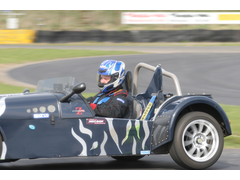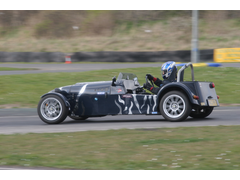

Rescued attachment IMG_3006.jpg

Had a fantastic day at the track today. Only slightly marred by breathing trouble.
This is the set up;
Oil filler cap is in std position in rocker cover, cap has outlet, this is piped straight to catch tank.
Metal can is in situ in the block, rubber grommet in top, std sierra PCV valve fitted, this has 2 small bore outlets at angles (engine was from
injected Sierra). Spring and plunger removed from PCV.
This is what i have tried:
1. Oil cap piped to catch tank. One of the crancase outlets blocked off, other piped to catch tank.
Result - Normal driving slow build up of liquid, no major worry. Hard driving results in fairly rapid filling of more concentrated oily mess.
My logic at this point was single c.case outlet too small, pressure still building up and forcing oil out. This led me to -
2. Second outlet that was blocked off now opened up. Piped into second catch tank read - beer can) with a small in line fuel filter in the line.
Second catch tank didnt fill at all. Main tank didnt fill as fast but still needed emtying after 15 - 20 laps.
3. As an experiment i removed the inline filter from second catch tank - within 5 laps this filled to overflowing and made a mess.
So there is the background. Now for the permanent fix.
Ive managed to source a Cortina oil trap as recommended here
http://members.aol.com/sarandrews/wateroil.htm
in the mean time to get me away ive sourced one of these (CVH crankcase breather)
Anyone used on and had success??
Next question - how do people pipe it all up?
My catch tank has 2 inlets and one outlet (for breather filter). So should i keep one from cap to tank and other from C.case breather / oil seperator
to catch tank. Ive also seen people pipe the oil filler to the tank and then just Tee in the c.case pipe to this. There seems to be so many
permutations? Let me know what worked for you so i can complete my research / anaylsis.
Cheers,
darren.Image deleted by owner
but you got some decent pictures...


Rescued attachment IMG_3006.jpg
and another...


Rescued attachment IMG_3040.jpg
darren take the one way valve out of the gromit and fit a larger pipe the size of the valve other end of pipe into tank then a pipe out the bottom of
tank back to sump + a fillter on the tank
Graham ps i think there is a plug on the side of the engine block that the return pipe could use
Not sure about any answers, but all I had on my Avon was a normal cap on the rocker cover without an outlet pipe (cap could breath though) and a right
angle outlet from the block to a catch tank that had two inlets at the top - one with a vent (small round k&n stylee filter) and one that
connected to the block.
Never had any problems and was fine after a day at Elvington (as Mr Helfire can vouch).
Pat...
I've used the old cortina oil separator / breather successfully.
I removed the valve in the outlet (with a drill, if I remember correctly!), and attached a large bore hose, which is run up over the inlet manifolds,
as high as possible, before looping back down to the catch tank inlet. I have an aftermarket camcover and oil filler cap, so no takeoffs there ...
just a simple breather hole in the oil filler cap. That breather hole has been blocked up, as per Dave Andrews website. The catch tank then has a
single outlet, which has a breather on it.
All works as expected. I get a little condensate in the catch tank, but no oil to speak of.
I suspect that you're seeing siphoning; once the oil is into the hoses to the catch tank, its got nowhere else to go. The big cortina oil
separator and the large-bore hoses help to stop that from happening ...
Hope thats useful.
Cheers
Richard
Just a thought but surely if you are getting that much oil through the breather, there must be too much blow-by gas indicating more sinister things lurking.
Thanks all.
I dont believe anything sinister is lurking. I have good compression and excellent oil pressure and the car is going very well indeed (albeit getting
strangled / restricted by the 38DGAS - the bike carbs will solve that).
What sixed up has said seems to stack up with my experiments yesterday. Having the fuel filter in line from crankcase breather seemed to act as an oil
seperator. That is all i could lay my hands on at short notice, the CVH breather seems to be a bigger version of the same that can be fitted direct to
the block breather can so the oil doesnt enter the pipework to catch tank. Cortine seperator will probs do the same but maybe more effectively as its
designed for the engine (i think).
Ill try the recommendations asap and report back. Looks like improved seperator and larger bore pipework is the way to go.
I have also found that with too much oil in sump (ie up to top mark on dipstick) makes the situation worse. Running between lower mark and middle
settles things down.
Couple of things that may be of use:
If possible blank off the filler on the cam cover as itís not in a good position to act as a breather. Weld a pipe onto the exhaust side of the rocker
behind one of the cam housings.
Junk all the PCV housing and use a block breather (Much bigger bore)
Vent both Rocker and Crankcase breathers to either individual or a single tank (If using a single tank ensure there is sufficient breathing to
atmosphere).
If using a 205 block take a pipe form the bottom of the catch tank and return via port provided at the back of the exhaust side of the block. If non
205 have a boss welded into your sump to provide a return.
Above cured my breathing problems, if of any use I will try to put a picture in my archive later.
Thanks
Duncan
Might also be worth fitting a baffle beneath the oil filler to stop oil being thrown directly towards the breather?
Oil filler cap already has a baffle underneath. I dont seem to have a major issue with oil being thrown out of the oil filler cap.
What i have been able to determine is that the CVH breather fits in place of the std PCV valve. Its not the tightest of fits so ive held mine down
with cable tie while i see how it performs. Ive piped the CVH breather to catch tank with 1/2" bore pipe (same as for oil filler cap).
Next job will be to lift the catch tank a touch (inlets are approx 1" lower than oil filler cap outlet so not too bad).
I may also Tee the crankcase pipe into filler pipe so that it is running vertically and not at a shallow angle to the catch tank (or get some more
flexible pipe).
Ref Catch tank height - what i dont understand is that a lot of people recommend fitting as high as possible (and i understand the theory on this) but
i have seen others with them fitted very low down and no breathing issues at all. As with most things there seems to be several permutations that work
in varying degrees of efficiency.
You can position the catch tank anywhere you like, provided the pipe to it runs as high as possible, before looping back down to the catch tank.
You're trying to avoid getting enough oil into the pipework leading to the catch tank to turn it into a siphon, which could remove a lot of oil
from the engine
Incidentally, I took a look at my old Cortina oil separator thing, and it appears to be internally baffled, which again leads me towards the view that
its trying to prevent siphoning...
Cheers
Richard
Well - a few weeks on and it looks like my mod has made an improvement but needs some further evolution. Ive done some searches on here and WSCC
boardroom which is all very interesting.
Next mod will be to look at piping the crankcase up to the pipe from oil filler cap to catch tank so i have a more vertical run and perhaps
investigate increasing the outlet diameter of the catch tank.
Anyway - whislt searching i read an interesting post from a guy who had done several K trouble free miles over a few years. Changed to fully synthetic
water thick oil and had all sorted of issues. Switched back to 20W50 and all sorted. It got me thinking. Im using 15W40 at the mo. Cant remember how
oil grades work so what is the diff between my current and 20W50 oil? i dont recall too many issues before i changed the engine and seem to recall
using the 20W50 before. Could this be a potential cause??
IIRC Pinto lumps should be run on 20/50
Fully synthetic water thick oil? What's that then?! 
The higher the number, the thicker the oil, so the thinner stuff you've been using will pick up and get blown out easier. Also thicker oil will
help to cut down blowby a bit helping a little extra too. The thinner stuff will get passed seals easier and can break some down, or could on my A
series stuff anyways
[Edited on 19/4/07 by DIY Si]